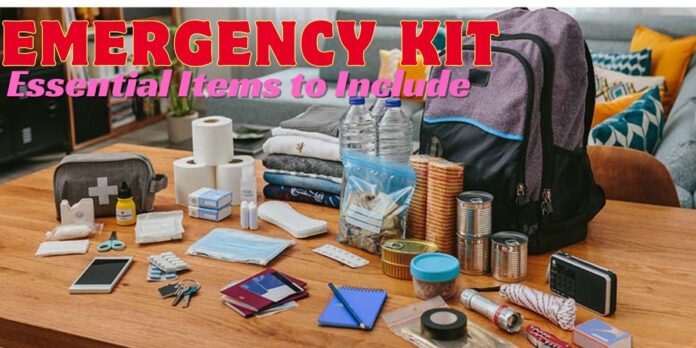Emergencies can strike without warning—be it a natural disaster like a hurricane or earthquake, a power outage, or a personal crisis such as a medical emergency. Being prepared with an emergency kit can mean the difference between safety and chaos during such situations. An effective emergency kit should contain essential items that cater to the basic needs of you and your family. This comprehensive guide will walk you through the essential items to include in your emergency kit today, ensuring that you are prepared for whatever life throws your way.
The Importance of an Emergency Kit
Before diving into the specifics, it’s crucial to understand why having an emergency kit is vital.
Peace of Mind: Knowing that you are prepared can alleviate anxiety and stress during emergencies.
Quick Access: An organized kit allows for quick access to supplies, which can be critical in high-pressure situations.
Safety and Health: An emergency kit can provide necessary supplies to keep you safe, healthy, and nourished during crises when regular resources might be unavailable.
What to Include in Your Emergency Kit
Your emergency kit should be tailored to meet the unique needs of your household, including the number of family members, pets, and any specific health considerations. Here are the essential items to include in your emergency kit today:
Water
Water is the most crucial component of any emergency kit. Aim for at least one gallon of water per person per day, and plan for a minimum of three days’ worth of supplies. Consider the following:
- Bottled Water: Store pre-packaged bottles, ideally sealed and stored in a cool, dark place.
- Water Purification Tablets: These tablets can purify questionable water sources in emergencies.
- Portable Water Filter: A filter can provide safe drinking water from natural sources if necessary.
Non-Perishable Food
Include enough non-perishable food items to last at least three days. Choose food that is easy to prepare and requires minimal cooking. Options include.
- Canned Goods: Vegetables, fruits, beans, and meats provide nutritional value and variety.
- Energy Bars: High-calorie and easy to pack, they are excellent for quick energy.
- Dried Fruits and Nuts: Good sources of nutrition and perfect for snacking.
- Ready-to-Eat Meals: Pre-packaged meals that only need to be heated are convenient and filling.
First Aid Supplies
Injuries can occur during emergencies, making a well-stocked first aid kit essential. Include.
- Adhesive Bandages: Various sizes for cuts and scrapes.
- Antiseptic Wipes: For cleaning wounds and preventing infection.
- Gauze and Tape: Essential for larger wounds.
- Pain Relievers: Keep over-the-counter medications like ibuprofen and acetaminophen.
- Prescription Medications: Store necessary medications for family members.
Tools and Equipment
Practical tools can be invaluable during emergencies. Include:
- Multi-Tool: A versatile tool that combines several functions.
- Flashlights: Battery-operated or solar-powered flashlights are essential for power outages.
- Extra Batteries: Ensure you have batteries for your tools and devices.
- Whistle: For signaling for help if needed.
- Duct Tape: Useful for repairs or securing items.
Shelter and Warmth
Having items to ensure shelter and warmth can be critical. Include:
- Emergency Mylar Blankets: Lightweight and can retain body heat.
- Tent or Tarp: Provides temporary shelter if you need to evacuate.
- Sleeping Bags: Compact sleeping bags can keep you warm.
- Hand Warmers: Disposable or reusable warmers for added comfort in cold conditions.
Personal Hygiene Items
Maintaining hygiene is essential, especially during emergencies. Include:
- Moist Towelettes: For cleaning when water is not available.
- Feminine Hygiene Products: Include necessary supplies for those who need them.
- Trash Bags: For disposing of waste and keeping the area clean.
Clothing and Footwear
Proper clothing can enhance comfort and safety during an emergency. Include:
- Extra Clothing: Weather-appropriate clothing, including socks and underwear.
- Sturdy Shoes: A durable pair of shoes suitable for walking.
- Rain Gear: Ponchos or raincoats for wet weather conditions.
Communication and Information
Staying informed is critical during emergencies. Ensure you have.
- Battery-Powered or Hand-Crank Radio: For receiving news and weather updates.
- Chargers: Solar chargers or portable power banks for your devices.
- Emergency Contact List: A printed list of important contacts for family and friends.
Cash and Important Documents
In emergencies, access to cash can be vital. Include:
- Cash: Small denominations for purchases.
- Important Documents: Copies of IDs, insurance policies, and medical information in a waterproof bag.
Family and Pet Supplies
Your emergency kit should cater to all family members, including pets. Include:
- Child Care Items: Diapers, formula, or any necessary supplies for infants.
- Pet Supplies: Food, water, and medications for pets, as well as leashes and carriers if needed.
Customizing Your Emergency Kit
While the items listed above are essential, customizing your emergency kit to fit your family’s unique needs is crucial. Consider:
- Health Conditions: Include any special medical supplies needed for chronic conditions.
- Cultural or Dietary Needs: Ensure food and supplies are appropriate for all family members.
- Age-Appropriate Items: Tailor items to meet the needs of children and elderly family members.
Regular Maintenance of Your Kit
Once you’ve assembled your emergency kit, it’s essential to maintain it regularly:
- Check Expiration Dates: Replace expired food and medications every six months.
- Update Personal Information: Ensure emergency contact information is current.
- Reassess Your Needs: As your family grows or changes, adjust the kit accordingly.
Preparing for Different Types of Emergencies
Understanding the type of emergencies most likely to affect your area can help you customize your kit further. Research the following:
- Natural Disasters: If you live in an area prone to hurricanes, earthquakes, or floods, ensure your kit includes items specific to those events.
- Power Outages: If you frequently experience blackouts, include additional batteries and alternative cooking methods.
- Evacuation Plans: Know your evacuation routes and have a plan for where to go in case of emergencies.
Conclusion
Being prepared with an emergency kit is not just a precaution; it’s a necessary step toward ensuring the safety and well-being of you and your loved ones. By including the essential items to include in your emergency kit today, you create a reliable resource that can sustain you during uncertain times. Regularly review and update your kit to ensure its effectiveness, and take pride in knowing you’re ready for whatever may come your way. Remember, preparation today can lead to peace of mind tomorrow.





